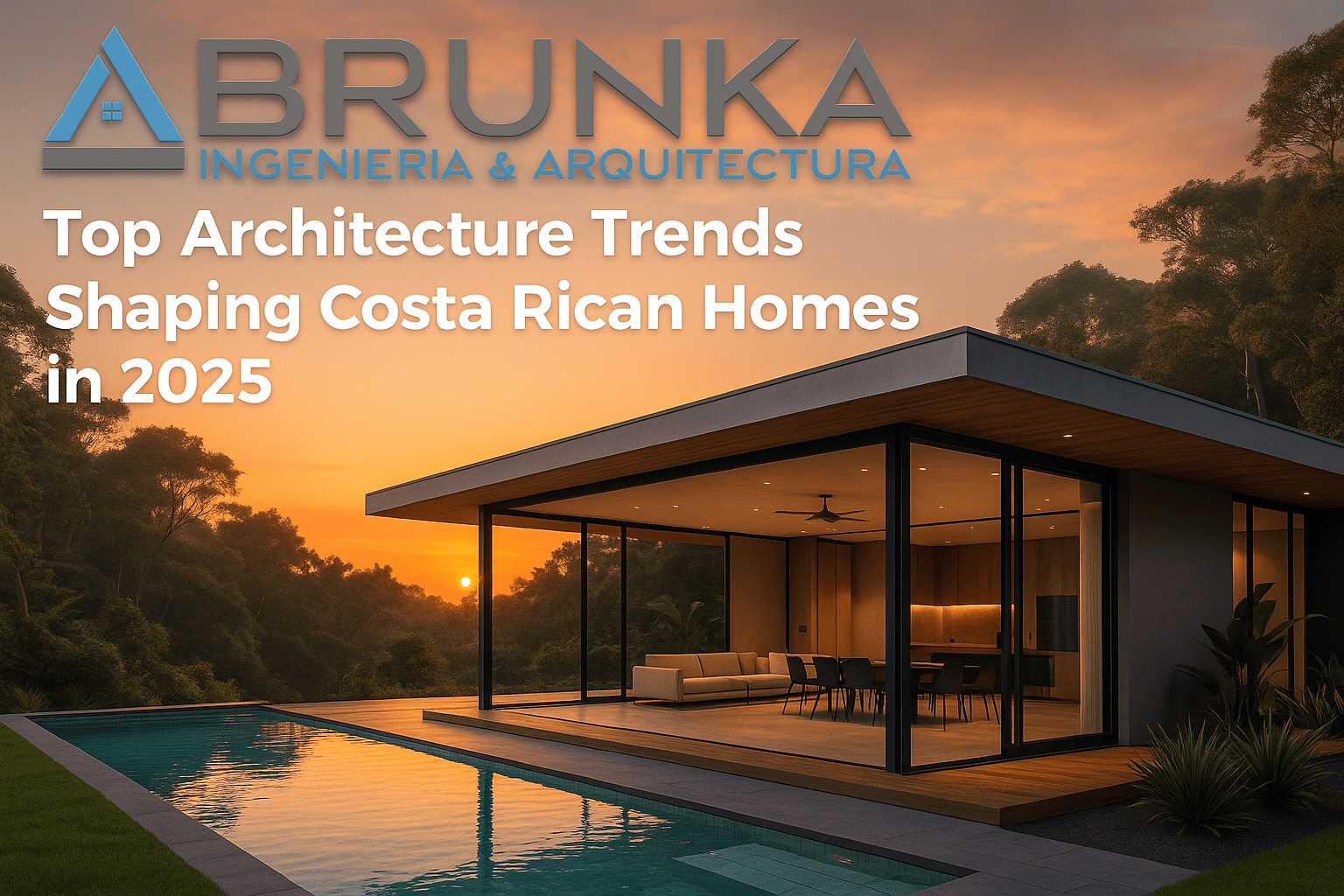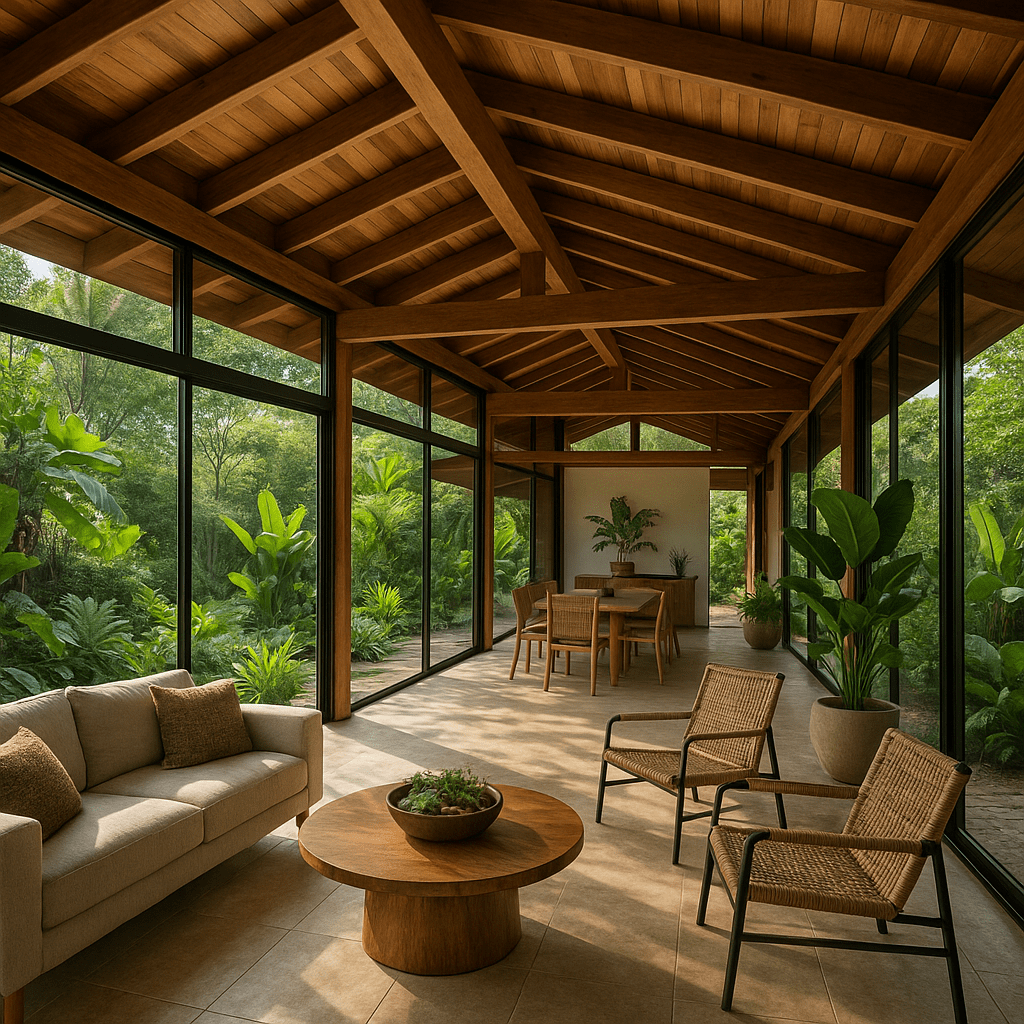
Top Architecture Trends Shaping Costa Rican Homes in 2025
Summary
- Costa Rica’s 2025 homes are built to live with nature, not against it.
- Passive cooling design slashes energy costs without heavy A/C.
- Sustainable, locally sourced materials redefine luxury.
- Smart, self-sufficient systems make tropical homes future-ready.
- Wellness spaces like yoga decks and infinity pools are now must-haves.
For over a decade, professionals in real estate and design in Costa Rica have observed a rapid evolution in home architecture. The homes are no longer just structures; they are a deep-rooted response to the environment, a philosophy that blends eco-consciousness with modern luxury. In 2025, the trends are a full-throttle embrace of nature-first design, a push for smart, self-sufficient systems, and a beautiful return to local craftsmanship. It’s no longer about placing a box in the jungle; it’s about creating a home that breathes with it. The results are breathtaking, efficient, and genuinely unique properties that truly belong to this land.
Trend 1: The Biophilic Revolution: Bringing the Outside In
Biophilic design is a central concept for new construction in Costa Rica. It focuses on creating a deeper connection between a building’s occupants and the natural world. This trend goes beyond adding a few potted plants; it’s a fundamental shift in how spaces are designed. Architects are using massive, floor-to-ceiling sliding glass walls that completely disappear, making the living room one with the jungle terrace. This provides a sensory experience, allowing residents to feel the warm, humid air, hear the birds, and smell the rain on the leaves—all from indoors. Homebuyers are now seeking an immersion in nature, not just a view.
A recent project near Nosara, for example, integrated a central, open-air courtyard with a single, mature Guanacaste tree. It became the heart of the home, providing natural shade, a cool breeze, and a constant reminder of the incredible ecosystem just outside the door. This approach is being applied to homes of all sizes, with many incorporating indoor water features, natural rock walls, and extensive green roofs that blend seamlessly with the landscape.
Trend 2: Passive Cooling & Climate-Smart Architecture
Relying on air conditioning in a tropical climate is an energy drain. The smartest new homes in Costa Rica are designed to stay cool without heavy reliance on A/C. This is where clever, climate-responsive architecture really shines. The focus is on passive cooling strategies that use natural elements to their advantage.
These strategies include:
- Strategic Cross-Ventilation: Homes are designed with windows and doors positioned to catch prevailing ocean or jungle breezes, creating a constant, natural airflow.
- Deep Overhangs and Pergolas: These architectural elements provide crucial shade, keeping direct sun off the walls and glass, which significantly reduces heat gain.
- High Ceilings and Vents: This creates a “chimney effect,” allowing hot air to rise and escape, pulling in cooler air from below. It’s a simple, effective concept for tropical climates.
The results of these strategies are undeniable. A home in Santa Teresa, designed with these principles, remained comfortable without air conditioning due to its open-air design and strategic positioning. This also contributes to a broader trend of sustainability, which is a major draw for international buyers. Building smart from the start not only lowers operating costs but also future-proofs the property.
For a deeper dive, see our Costa Rica building permits guide to understand how eco-smart strategies align with legal requirements.And for global best practices, explore Google Search Central insights on sustainability and discoverability.

Trend 3: Sustainable Materials & Local Craftsmanship
The new standard for luxury is authenticity and sustainability. Homeowners want to know where their materials come from, and they want them to tell a story.
- Locally Sourced Wood: Ethically sourced tropical hardwoods like teak and melina are being used for everything from structural beams to custom cabinetry and furniture. These woods are not only stunning but are also naturally resistant to moisture and pests.
- Natural Stone and Polished Concrete: These materials are durable, easy to maintain, and their cool, earthy feel is perfect for the minimalist, organic aesthetic that is popular in the region. Polished concrete floors that extend seamlessly from the kitchen to the outdoor patio are a common feature.
- Rattan, Jute, and Woven Elements: Interior design is embracing natural, hand-woven textures. These materials add warmth and a bohemian touch that complements the raw, modern architecture.
Incorporating a hand-carved, local Guanacaste wood dining table in a client’s home, for instance, not only created a conversation piece but also directly supported a local artisan. The blend of modern, clean lines with these natural, often-imperfect materials creates a unique and soulful atmosphere.
If you’re planning to source eco-materials for your project, our architecture services in Costa Rica ensure your build respects both tradition and sustainability.
Trend 4: Smart Home Integration (Designed for Pura Vida)
In 2025, smart home technology is about seamless, intuitive systems that enhance the Pura Vida lifestyle, not complicate it. The goal is to make life easier and more efficient, without a single visible wire.
The most popular smart home features include:
- Automated Lighting & Shade Systems: These systems adjust lighting automatically based on the time of day and allow for control of shades to manage light and privacy.
- Off-Grid and Energy Management Systems: Homes are being built with solar panels and high-capacity battery storage systems from the start. This makes the home more self-sufficient and acts as a backup during power outages.
- Security & Surveillance: For properties that are second homes, a reliable, remote security system is essential. The top systems offer real-time monitoring and control from anywhere in the world.
These systems are being integrated in a way that respects the architecture, with minimalist switches and speakers hidden in the ceiling. The technology serves the design, rather than dominating it.
Trend 5: Infinity Pools, Elevated Spaces & Wellness Zones
A pool in Costa Rica is a design statement. Infinity pools continue to be a dominant trend, but they are evolving. There is a growing preference for natural saltwater filtration systems and pools with organic shapes that follow the contours of the land.
Furthermore, luxury homes are now designed with dedicated wellness zones. This goes beyond a simple home gym. The trend includes:
- Open-Air Yoga and Meditation Shalas: These are often elevated platforms nestled into the jungle, providing a serene space for practice.
- Jungle-Integrated Massage Pavilions: Spaces designed for a massage surrounded by the sounds and scents of the rainforest.
- Private Plunge Pools and Cold Tubs: For post-workout recovery or a refreshing dip.
These spaces are woven into the architectural plan from day one. The use of elevated platforms and stilts is another trend, used not only for better views but also to minimize the home’s footprint on the land, allowing natural water flow and wildlife to pass underneath.
Conclusion
Costa Rica’s architectural evolution in 2025 proves one truth: the country is leading, not following. Homes here are no longer simple dwellings; they’re ecosystems that harmonize with climate, culture, and lifestyle. From passive cooling strategies to biophilic courtyards and self-sufficient smart systems, every detail is designed for a better, more sustainable life.
If you’re considering building or renovating in Costa Rica, choosing the right professionals is crucial. That’s why partnering with Architect Engineer ensures your home is not only beautiful, but also sustainable, legal, and built for the future.
FAQs
Q1: What are the main advantages of building a home in Costa Rica with a focus on these trends?
A: Focusing on these trends results in a home that is more energy-efficient, has lower operating costs, and is more in tune with the environment. This not only provides a better living experience but also increases the property’s long-term value and resale potential.
Q2: How much more expensive is it to build a sustainable home in Costa Rica?
A: While some sustainable materials or systems like solar may have a higher upfront cost, the long-term savings on energy and maintenance often offset the initial investment. The key is to work with an architect experienced in sustainable design to ensure a balanced budget.
Q3: Can these architectural trends be applied to a home renovation, or are they only for new construction?
A: Many of these trends, such as incorporating natural materials, improving cross-ventilation, and integrating smart home technology, can be successfully applied to renovation projects. The best approach is to consult with a design professional to determine what is feasible for a specific property.
Q4: How do architects ensure homes are secure while maintaining an open-air design?
A: Security is a top priority. Expert architects use integrated security systems, strategically placed surveillance, and perimeter design to create a secure environment. For instance, while glass walls may disappear during the day, they are often equipped with high-tech, reinforced locking mechanisms. Additionally, many luxury homes are located within gated communities with 24/7 security personnel.
Q5: What are the main advantages of a biophilic home design in Costa Rica?
A: Biophilic design in Costa Rica homes offers significant advantages, including reduced stress levels, improved cognitive function, and a heightened sense of well-being by strengthening the connection between the resident and the natural environment. These designs also promote better air quality and often result in lower energy costs through passive cooling.



